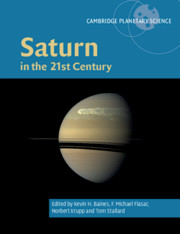Book contents
- Saturn in the 21st Century
- Cambridge Planetary Science
- Saturn in the 21st Century
- Copyright page
- Contents
- Contributors
- Reviewers
- 1 Introduction to Saturn in the 21st Century
- 2 The Origin and Evolution of Saturn, with Exoplanet Perspective
- 3 The Interior of Saturn
- 4 Saturn’s Magnetic Field and Dynamo
- 5 The Mysterious Periodicities of Saturn
- 6 Global Configuration and Seasonal Variations of Saturn’s Magnetosphere
- 7 Saturn’s Aurorae
- 8 Saturn’s Ionosphere
- 9 Saturn’s Variable Thermosphere
- 10 Saturn’s Seasonally Changing Atmosphere
- 11 The Global Atmospheric Circulation of Saturn
- 12 Saturn’s Polar Atmosphere
- 13 The Great Saturn Storm of 2010–2011
- 14 The Future Exploration of Saturn
- Index
- References
10 - Saturn’s Seasonally Changing Atmosphere
Thermal Structure, Composition and Aerosols
Published online by Cambridge University Press: 13 December 2018
- Saturn in the 21st Century
- Cambridge Planetary Science
- Saturn in the 21st Century
- Copyright page
- Contents
- Contributors
- Reviewers
- 1 Introduction to Saturn in the 21st Century
- 2 The Origin and Evolution of Saturn, with Exoplanet Perspective
- 3 The Interior of Saturn
- 4 Saturn’s Magnetic Field and Dynamo
- 5 The Mysterious Periodicities of Saturn
- 6 Global Configuration and Seasonal Variations of Saturn’s Magnetosphere
- 7 Saturn’s Aurorae
- 8 Saturn’s Ionosphere
- 9 Saturn’s Variable Thermosphere
- 10 Saturn’s Seasonally Changing Atmosphere
- 11 The Global Atmospheric Circulation of Saturn
- 12 Saturn’s Polar Atmosphere
- 13 The Great Saturn Storm of 2010–2011
- 14 The Future Exploration of Saturn
- Index
- References
Summary
The longevity of Cassini’s exploration of Saturn’s atmosphere (a third of a Saturnian year) means that we have been able to track the seasonal evolution of atmospheric temperatures, chemistry and cloud opacity over almost every season, from solstice to solstice and from perihelion to aphelion. Cassini has built upon the decades-long ground-based record to observe seasonal shifts in atmospheric temperature, finding a thermal response that lags behind the seasonal insolation with a lag time that increases with depth into the atmosphere, in agreement with radiative climate models. Seasonal hemispheric contrasts are perturbed at smaller scales by atmospheric circulation, such as belt/zone dynamics, the equatorial oscillations and the polar vortices. Temperature asymmetries are largest in the middle stratosphere and become insignificant near the radiative-convective boundary. Cassini has also measured southern-summertime asymmetries in atmospheric composition, including ammonia (the key species forming the topmost clouds), phosphine and para-hydrogen (both disequilibrium species) in the upper troposphere; and hydrocarbons deriving from the UV photolysis of methane in the stratosphere (principally ethane and acetylene). These chemical asymmetries are now altering in subtle ways due to (i) the changing chemical efficiencies with temperature and insolation and (ii) vertical motions associated with large-scale overturning in response to the seasonal temperature contrasts. Similarly, hemispheric contrasts in tropospheric aerosol opacity and coloration that were identified during the earliest phases of Cassini’s exploration have now reversed, suggesting an intricate link between the clouds and the temperatures. Finally, comparisons of observations between Voyager and Cassini (both observing in early northern spring, one Saturn year apart) show tantalizing suggestions of non-seasonal variability. Disentangling the competing effects of radiative balance, chemistry and dynamics in shaping the seasonal evolution of Saturn’s temperatures, clouds and composition remains the key challenge for the next generation of observations and numerical simulations.
- Type
- Chapter
- Information
- Saturn in the 21st Century , pp. 251 - 294Publisher: Cambridge University PressPrint publication year: 2018
References
- 7
- Cited by

